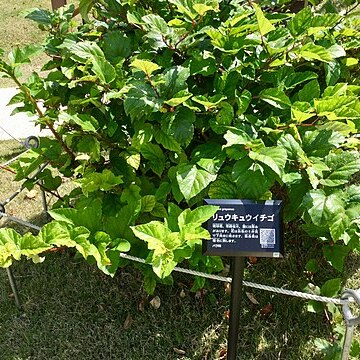Shrubs 0.5–2 m tall. Branchlets brownish to purplish brown, slightly angled, glabrous, nearly unarmed or with sparse prickles. Leaves simple; petiole 2–3 cm, slender, glabrous, with sparse, minute prickles; stipules linear, 5–7 mm, glabrous; blade ovate to elliptic, 7–10 × 3–6 cm, both surfaces glabrous, or with few soft hairs only along veins, abaxially with sparse, minute prickles along midvein, base truncate to cordate, margin often undivided, sometimes 3–5-lobed, unevenly coarsely sharply serrate to doubly serrate, apex acuminate to caudate. Inflorescences terminal on short branchlets, 1-flowered. Pedicel 1–2.5 cm, glabrous, occasionally with sparse, glandular hairs. Flowers to 2 cm in diam. Calyx abaxially glabrous; tube pelviform; sepals spreading or reflexed in fruit, ovate-triangular, 0.8–1.4 cm × 3–5 mm, margin tomentose, apex caudate. Petals red, 0.8–1.4 cm in diam., nearly as long as or slightly longer than sepals, glabrous, base shortly clawed. Stamens many; filaments and anthers purplish red. Pistils numerous, more than 100, shorter than stamens; ovary purplish red, glabrous; styles glabrous. Aggregate fruit yellowish red, ovoid-globose, 1–1.2 cm in diam., glabrous; pyrenes reniform, small, foveolate. Fl. Apr–May, fr. Jun–Jul. 2n = 14.
More
A shrub. It grows 2 m tall. The branches are brown and slightly angled. It only has a few prickles. The leaves are simple and oval. They are 7-10 cm long by 3-6 cm wide. Flowers occur singly at the ends of branches and are 2 cm across. The petals are red. The fruit is aggregate and yellowish-red. They are oval and 1-1.2 cm across.
It is a subtropical plant. It grows in sunny areas on slopes, and in valleys near water. It grows between 300-1,100 m above sea level.
More
Slopes, open sunny areas, montane valleys, thickets and mixed forests along watercourses; at elevations from 300-1,100 metres.
Can be grown by cuttings or seedlings. Seeds needs stratification.

